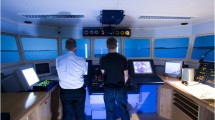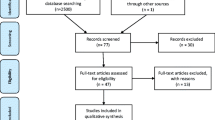Abstract
The theoretical contribution of this paper lies in introducing the concept of social fidelity to bridge the gap between computer technology and collaborative learning activities in simulator-based training. The concept has usually been limited to the technological aspects of simulator training with an assumption that a high level of fidelity equals a high physical resemblance between a simulator and the real work environment. The objective of this article is to expand the prevailing understanding of the concept of simulator fidelity and explore social factors that may influence perceived training quality among professional maritime officers. This qualitative study aims to broaden the scope from technological aspects to an emphasis on task and collaborative factors. The empirical material used is based on observations of two different simulator programs for professional maritime officers and focused interviews with bridge officers participating in the sampled training. The research aims to deepen the knowledge on how learning unfolds in a simulator-based training context characterised by extensive use of advanced computer technology and collaborative activities. The research demonstrates how trainer–trainee interactions, task factors and simulator technology may influence perceived level of fidelity and training quality. The article is concluded by offering a set of recommendations for future design of maritime simulator-based training.

Similar content being viewed by others
References
Alessi SM, Trollip SR (2001) Multimedia for learning. Methods and development. Allyn & Bacon, Massachusetts
Allen JA, Hays RT, Buffardi LC (1986) Maintenance training simulator fidelity and individual differences in transfer of training. Hum Factors 28(5):497–509
Aubert V, Arner O (1959) On the social structure of the ship. Acta Sociol 3(4):200–219
Brown JS, Duguid P (2000) The social life of information. Harvard Business School Press, Boston
Bryman A (2012) Social research methods. Oxford University Press, New York
Charmaz K (2014) Construction grounded theory. SAGE Publications Ltd., London
Chricton MT (2017) From cockpit to operating theatre to drilling floor: Five principles for improving safety using simulator-based exercises to enhance team cognition. Cogn Technol Work 19:73–84
Dahlstrom N, Dekker S, van Winsen R, Nyce J (2009) Fidelity and validity of simulator training. Theorl Issues Ergon Sci 10(4):305–314
Dailey SL, Browning L (2014) Retelling stories in organizations: understanding the functions of narrative repetition. Acad Manag Rev 39(1):22–43
Emad G, Roth WM (2008) Contradictions in the practices of training for and assessment of competency. Educ Train 50(3):260–272
Emad G, Roth WM (2016) Quasi-communities: rethinking learning in formal adult and vocational training. Instr Sci 44:583–600
Gherardi S (2017) A practice-based approach to safety as an emergent competence. In: Bieder C, Gilbert C, Journé B, Laroch H (eds) Beyond safety training: Embedding safety in professional skills. Springer Open, Cham, pp 11–22
Ghosh S, Bowles M, Ranumuthugala D, Brooks B (2016) Authentic assessment in seafarer education: using literature review to investigate its validity and reliability through rubrics. WMU J Marit Aff 15:317–336
Hale A, Borys D (2013) Working to rule, or working safely? Part 1: a state of the art review. Saf Sci 55:207–221
Hamstra SJ, Brydges R, Hatala R, Zendejas B, Cook DA (2014) Reconsidering fidelity in simulation-based training. Acad Med 89(3):387–392
Hanzu-Pazara R, Barsan E, Arsenie P, Chiotoroiu L, Raicu G (2008) Reducing of maritime accidents caused by human factors using simulators in training process. J Marit Res 5(1):3–18
Håvold JI, Nistad S, Skiri A, Ødegård A (2015) The human factor and simulator training for offshore anchor handling operators. Saf Sci 75:136–145
Hollnagel E (2018) Safety-II in practice. Developing the resilience potentials. Routledge, Oxon
Hontvedt M (2015) Professional vision in simulated environments—examining professional maritime pilots’ performance of work tasks in a full-mission ship simulator. Learn Cult Soc Interact 7:71–84
Hontvedt M, Arnseth HC (2013) On the bridge to learn: analysing the social organization of nautical instruction in a ship simulator. Int J Comp Support Collab Learn 8:89–112
Hung D, Cheng V (2002) Understanding how thriving internet quasi-communities work: Distinguishing between learning about and learning to be. Educ Technol 42(1):23–27
International Maritime Organisation (2011) International convention on standards of training, certification and watchkeeping for seafarers. STCW. Including 2010 Manila Amendments. IMO, London
Kirschner PA, Sweller J, Kirschner F, Zambrano RJ (2018) From cognitive load theory to collaborative load theory. Int J Comp Support Collab Learn 13(2):213–233
Kongsberg M (2018) Positioning systems, DP/thruster/joystick. Kongsberg. https://www.km.kongsberg.com/ks/web/nokbg0240.nsf/AllWeb/14E17775E088ADC2C1256A4700319B04?OpenDocument. Accessed 18 June 2018
Lave H, Wenger E (1991) Situated learning. Legitimate peripheral participation. Cambridge University Press, Cambridge
Liu D, Macchiarella ND, Vincenzi DA (2009) Simulator fidelity. In: Vincenzi DA, Wise JA, Mouloua M, Hancock PA (eds) Human factors in simulation and training. CRC Press, Boca Raton, pp 61–73
Ludvigsen S, Cress U, Law N, Stahl G, Rosé CP (2018) Multiple forms of regulation and coordination across levels in education settings. Int J Comp Support Collab Learn 13:1–6
Merton RK, Kendall PL (1946) The focused interview. Am J Sociol 51(6):541–557
Moroney WF, Lilienthal MG (2009) Human factors in simulation and training. An overview. In: Vincenzi DA, Wise JA, Mouloua M, Hancock PA (eds) Human factors in simulation and training. CRC Press, Boca Raton, pp 3–38
Rystedt H, Sjöblom B (2012) Realism, authenticity, and learning in healthcare simulations: Rules of relevance and irrelevance as interactive achievements. Instr Sci 40:785–798
Salas E, Bowers CA, Rhodenizer l (1998) It is not how much you have but how you use it: Toward a rational use of simulation to support aviation training. Int J Aviat Psychol 8(3):197–208
Sellberg C (2017) Simulators in bridge operations training and assessment: A systematic review and qualitative synthesis. WMU J Marit Aff 16:247–263
Sheridan TB (2012) Human supervisory control. In: Salvendy G (ed) Handbook of Human Factors and Ergonomics. John Wiley and Sons, Chichester, pp 990–1015
Snook SA (2000) Friendly fire. Princeton University Press, New Jersey
Taylor DCM, Hamdy H (2013) Adult learning theories: Implications for learning and teaching in medical education: AMEE guide No. 83. Med Teach 35(11):1561–1572
Tjora A (2018) Qualitative research as stepwise-deductive induction. Routledge, London
Vaughan D (1996) The Challenger launch decision. The University of Chicago Press, Chicago
Wahl AM, Kongsvik T (2017) Leadership @ sea: essential non-technical skills. In: Cepin M. and Bris R. (eds.). Safety and reliability—theory and applications. In: Proceedings of the 27th European safety and reliability conference (ESREL 2017), Portoroz, Slovenia, 18–22 June 2017. London: CRC Press
Wahl AM, Kongsvik T (2018) Crew resource management training in the maritime industry: a literature review. WMU J Marit Aff 17:377–396
Wenger E (1998) Communities of practice. Cambridge University Press, Cambridge
Wenger E (2000) Communities of practice and social learning systems. Organisation 7(2):225–246
Woods DD, Dekker S, Cook R, Johannesen L, Sarter N (2010) Behind human error. Ashgate, Surrey
Acknowledgements
The study is funded by The Research Council of Norway, Grant No. 256074.
Author information
Authors and Affiliations
Corresponding author
Additional information
Publisher’s Note
Springer Nature remains neutral with regard to jurisdictional claims in published maps and institutional affiliations.
Rights and permissions
About this article
Cite this article
Wahl, A.M. Expanding the concept of simulator fidelity: the use of technology and collaborative activities in training maritime officers. Cogn Tech Work 22, 209–222 (2020). https://doi.org/10.1007/s10111-019-00549-4
Received:
Accepted:
Published:
Issue Date:
DOI: https://doi.org/10.1007/s10111-019-00549-4




